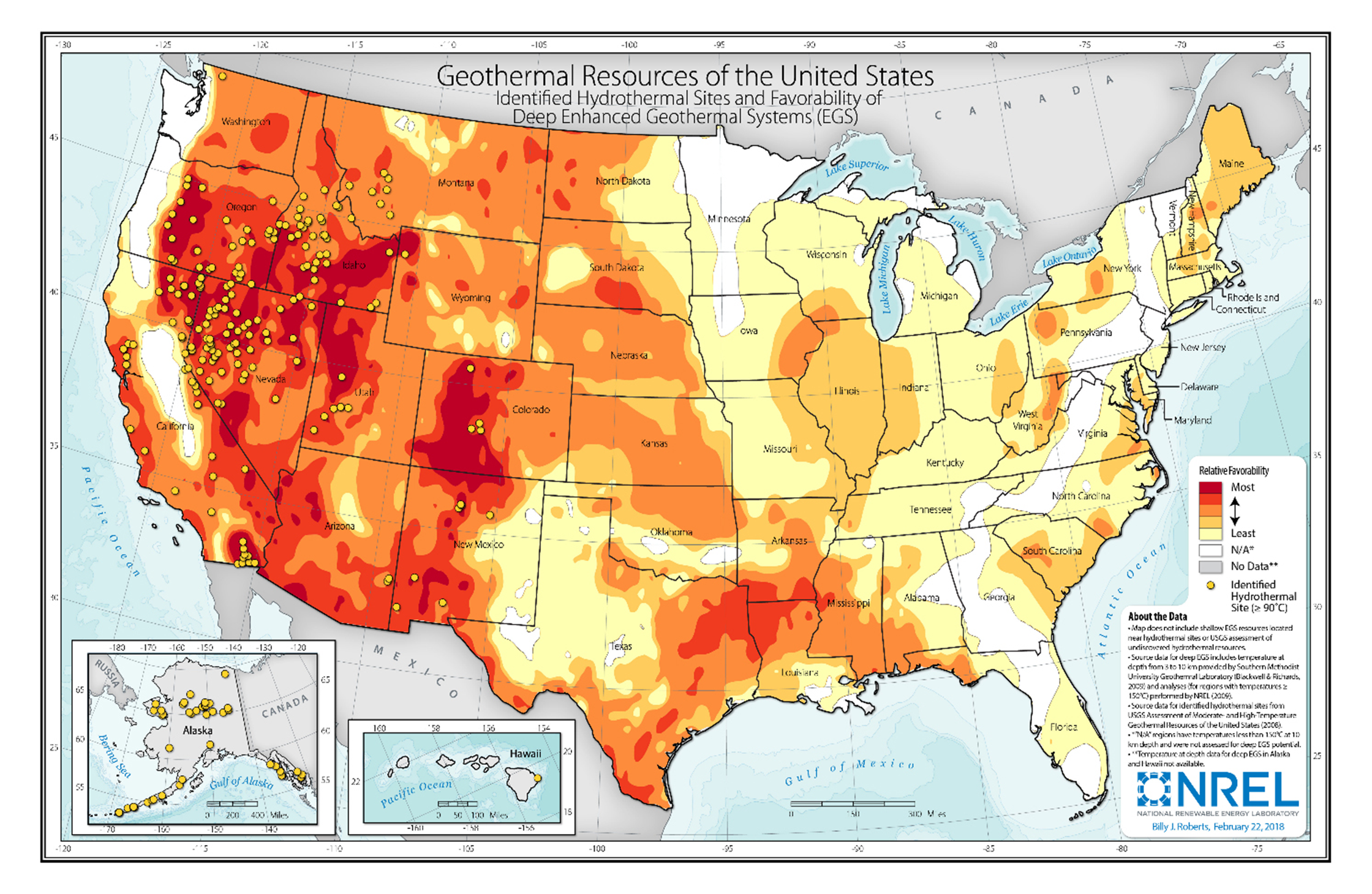Deep EGS resource favorability and identified hydrothermal sites. Figure 1, ‘Enhanced Geothermal Shot Analysis for the Geothermal Technologies Office’ (National Renewable Energy Laboratory). Figure by Billy Roberts, NREL.
Good news: we are gaining access to an abundant and reliable energy source that is literally beneath our feet.
Solar and wind get a lot of attention because we can all see the sun every day and feel the wind against our faces. The efficiencies have gone way up and the cost way down over the last fifty years, so some people have concluded that’s all we need.
In some places, yes. But in most places, the combination is insufficient because the wind doesn’t always blow at night. Energy storage can help, but it’s expensive, particularly when winds cease for days at a time. Moreover, local opposition (from both the left and the right) is growing to the mammoth turbines that are most capable of producing cheap electricity.
Nuclear energy can play an important role, but in this column, I’d like to dwell on another reliable form of electricity production that is available throughout the western U.S. I’m referring to geothermal energy.
We have tapped into geothermal energy in thermally active regions like Iceland for decades. But the methods used in the past only work where hot rock and water are present near the surface. As of 2019, worldwide geothermal energy production was 15.4 Gigawatts, less than 1% of global electricity production.
Two new methods have opened up geothermal energy to much more land. Both involve drilling deeper, a mile or more below the surface, to access rock hotter than 150 degrees Celsius, which is available almost anywhere in the Western U.S. Getting that heat to the surface requires pipes through which hot water can flow.
Enhanced Geothermal Systems (EGS) consist of two vertical pipes, one through which hot water is pumped up to the surface, the other through which cool water is pumped down to replenish the water that is pumped up. By using fracking methods to fracture the rock between the pipes so that water can move from the end of one pipe to the other, EGS can be deployed anywhere the rock is sufficiently hot, not just where the rock is hot and naturally permeable. This method opens up many more places for EGS to produce power.
Advanced Geothermal Systems (AGS) used closed-loop systems that include horizontal pipes at the surface and at the bottom of the two vertical pipes, so that fracturing is not required and water is conserved.
Electricity is generated by turbines driven by either steam or by vapor from a fluid with a lower boiling temperature that is heated by the hot water.
The beauty of EGA and AGS is that we already have an abundant source of skilled workers to drill deep and install the pipes. The oil and gas industry uses horizontal as well as deep vertical drilling to tap into fossil fuels. Workers in those industries can switch to drilling for enhanced and advanced geothermal energy.
For example, using drilling skills developed and refined in the oil and gas fracking industry, AGS startup Fervo recently drilled two wells 7700 feet deep and a 3250 feet horizontal connector in Nevada that is producing 3.5 megawatts of electricity and more recently drilled a three-mile deep AGS in Utah in just 16 days.
In 2020, the U.S. Department of Energy estimated that EGS can produce 60 GW of electricity in the U.S. by 2050, meeting 16% of U.S. electricity needs. How much is produced depends very much on how quickly the cost can be reduced. In 2022, the U.S. Department of Energy set a goal of reducing the cost of EGS by 90% to 45 cents per megawatt hour by 2035. (For reference, in Washington, we currently pay almost twice that amount — about 80 cents per megawatt hour). A Princeton University student estimated that if cost reductions from experiential learning10 follow the same rate as for solar energy, several 100s of GW of geothermal power could be produced in the U.S. alone. That would be a large fraction of U.S. power production.
We all know the Republican Big Beautiful Bill is rapidly phasing out tax credits for electric vehicles, heat pumps, energy efficiency in buildings, and solar and wind power. What is less known is that, thanks to advocacy by our own congressional representative Dan Newhouse, tax credits for nuclear and geothermal energy were preserved in the bill. This distinction makes sense, because costs for solar and wind have already declined. Costs for nuclear and geothermal can also decline, but subsidies are needed now as new technologies are developed for them.
So, we can look forward to geothermal technology providing cheap, reliable, abundant electrical power with a small surface footprint (other than transmission lines) for many years to come. That’s good news!
Steve Ghan leads the Tri-Cities Chapter of Citizens' Climate Lobby.


